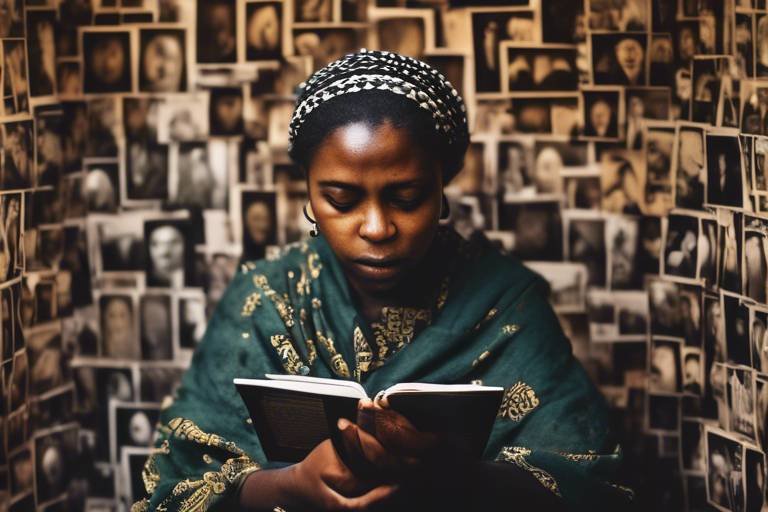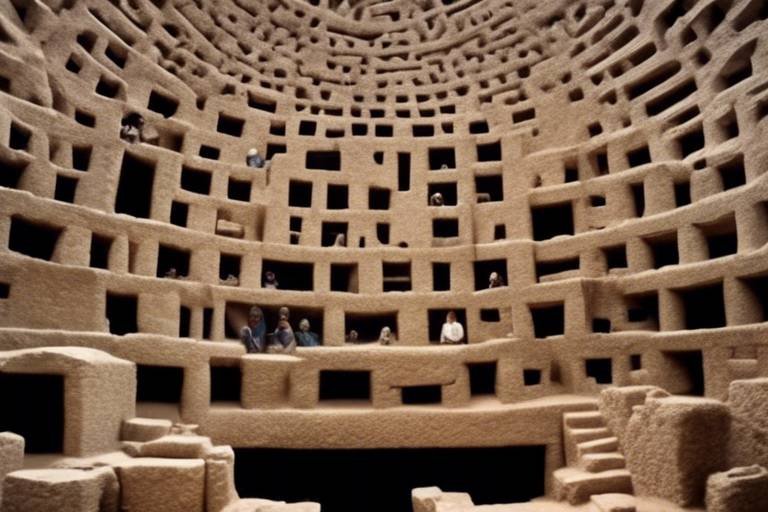Exploring the Intersection of Technology and Cultural Heritage
Technology and cultural heritage are two seemingly distinct realms that have converged in a fascinating intersection, giving rise to innovative approaches in preserving and showcasing the richness of our past. This amalgamation of traditional heritage and cutting-edge technology has opened up a realm of possibilities, revolutionizing the way we interact with and appreciate our cultural legacy.

Virtual Reality in Cultural Preservation
Virtual Reality (VR) has emerged as a groundbreaking technology in the realm of cultural preservation, offering innovative ways to safeguard and showcase our rich heritage. By immersing users in digital recreations of historical sites and artifacts, VR is revolutionizing the way we experience and interact with the past.
One of the key advantages of VR in cultural preservation is its ability to transport individuals to distant locations and time periods, allowing them to explore ancient civilizations and monuments as if they were physically present. Through immersive experiences, users can gain a deeper appreciation for the significance of these cultural treasures.
Moreover, VR enables the preservation of fragile or endangered heritage sites by creating detailed digital replicas that can be accessed and studied without risking damage to the original artifacts. This technology plays a crucial role in documenting and safeguarding our cultural legacy for future generations.
Furthermore, VR experiences can be enhanced with interactive elements, such as virtual tours guided by knowledgeable experts or educational narratives that provide historical context and insights. This interactive approach not only engages users but also fosters a deeper understanding and connection to the cultural significance of the sites being explored.
Overall, virtual reality is a powerful tool that is reshaping the landscape of cultural preservation, offering new ways to engage with our shared heritage and ensuring that it remains accessible and relevant in the digital age.

Augmented Reality Enhancements
Augmented reality (AR) is reshaping the way we experience and interact with cultural heritage sites, offering a blend of the physical world with digital enhancements. By overlaying computer-generated images onto the real environment, AR provides visitors with a unique and immersive journey through history. Imagine standing in front of ancient ruins and using your smartphone or AR glasses to see a reconstruction of the site as it once stood, bustling with life and activity. This technology bridges the gap between the past and present, allowing users to explore and learn in a dynamic and engaging manner.
One of the key enhancements brought by AR is the ability to superimpose digital information onto physical objects, enriching the visitor's understanding and appreciation of cultural artifacts. For example, at a museum exhibit, AR can provide detailed descriptions, historical context, and interactive elements when viewed through a mobile device or AR headset. This not only enhances the educational value of the experience but also caters to different learning styles, making the information more accessible and engaging for a diverse audience.
Moreover, AR allows for the creation of interactive storytelling experiences within heritage sites, bringing narratives to life through digital overlays and multimedia content. Visitors can witness historical events unfold before their eyes, walk through virtual reconstructions of ancient cities, or even interact with virtual characters from the past. This fusion of reality and digital content creates a multisensory exploration of cultural heritage, fostering a deeper connection and emotional engagement with the stories being told.

3D Scanning Techniques
When it comes to preserving cultural artifacts and heritage sites, have emerged as a groundbreaking technology that is revolutionizing the way we document and digitize these valuable pieces of history. By utilizing advanced scanning technologies, experts are able to create highly detailed 3D models of artifacts and sites, allowing for in-depth analysis and preservation efforts.
One of the key benefits of is the ability to capture intricate details that may be difficult to observe with the naked eye. By creating precise digital replicas of artifacts, researchers can study them in great detail without risking damage to the original pieces. This technology also enables experts to share these 3D models with a global audience, allowing people from all over the world to explore and learn about cultural heritage in a virtual space.
Furthermore, play a crucial role in conservation efforts by providing a non-invasive method of documenting artifacts and sites. Traditional methods of preservation often involve physical contact with the objects, which can lead to wear and tear over time. With 3D scanning, experts can create accurate representations of artifacts without ever having to touch them, ensuring their longevity for future generations to appreciate.
Moreover, the use of in cultural heritage preservation is not limited to stationary objects. Archaeologists and researchers are also employing this technology to document and analyze entire archaeological sites, capturing the layout and structure in a digital format. This allows for virtual reconstructions and simulations that provide valuable insights into the history and significance of these sites.
In conclusion, are a powerful tool in the realm of cultural heritage preservation, offering a way to safeguard and study our shared history in a digital age. By harnessing the capabilities of advanced scanning technologies, experts can unlock new possibilities for research, education, and immersive experiences that bring the past to life in ways never before imagined.

Mobile Applications for Cultural Education
Mobile applications have emerged as powerful tools for cultural education, offering users a convenient way to explore and learn about heritage sites from anywhere in the world. These applications provide a wealth of historical information, interactive maps, virtual tours, and multimedia content to enhance the user experience. By leveraging the capabilities of smartphones and tablets, users can delve into the rich history of cultural artifacts and archaeological sites with just a few taps on their screens.

Artificial Intelligence in Cultural Analysis
Artificial intelligence (AI) has emerged as a powerful tool in the realm of cultural analysis, offering new ways to interpret and understand the complexities of heritage. By harnessing the capabilities of AI, researchers and historians can delve deeper into the nuances of cultural artifacts, languages, and traditions, uncovering hidden insights that may have remained undiscovered through traditional methods alone. AI algorithms can sift through vast amounts of data, identifying patterns, trends, and correlations that provide valuable context and meaning to cultural phenomena.
One of the key applications of AI in cultural analysis is in the field of image recognition and classification. AI-powered systems can analyze visual data from artworks, archaeological finds, and historical documents, identifying stylistic elements, motifs, and themes that can offer clues about their origins and significance. This automated process not only speeds up the research and analysis process but also opens up new avenues for understanding the cultural context in which these artifacts were created.
Moreover, AI plays a crucial role in natural language processing, enabling researchers to analyze and translate texts in different languages, dialects, and scripts. By leveraging machine learning algorithms, AI can decipher ancient scripts, transcribe historical documents, and extract meaningful information from texts that may be fragmented or deteriorated. This capability not only aids in the preservation of linguistic heritage but also facilitates cross-cultural communication and understanding.
Furthermore, AI technologies are being used to create virtual simulations and reconstructions of historical sites and monuments, allowing researchers and the public to experience these cultural treasures in a dynamic and interactive way. By combining AI with virtual reality and augmented reality technologies, cultural analysts can recreate lost civilizations, architectural wonders, and artistic masterpieces, offering a glimpse into the past that is both immersive and educational.
In conclusion, artificial intelligence is revolutionizing the field of cultural analysis by providing innovative tools and methodologies for exploring and interpreting heritage in all its diversity. By harnessing the power of AI, researchers can unlock new insights, preserve cultural knowledge, and engage audiences in meaningful ways that transcend traditional boundaries of time and space.

Machine Learning Algorithms
Machine learning algorithms play a crucial role in the processing and analysis of vast amounts of cultural data to extract valuable insights and patterns. These algorithms enable researchers and experts to uncover hidden connections and trends within cultural heritage information that may not be apparent through traditional methods. By utilizing machine learning, cultural institutions can enhance their understanding of historical artifacts, sites, and traditions, leading to more informed decision-making in preservation and research efforts.

Digital Archives and Online Exhibitions
When it comes to preserving and showcasing cultural heritage in the digital age, the creation of digital archives and online exhibitions plays a pivotal role. These innovative platforms not only make cultural artifacts and historical information more accessible but also provide a dynamic and interactive experience for a global audience.
Digital archives serve as virtual repositories for a wide range of cultural materials, including documents, photographs, videos, and audio recordings. By digitizing these resources, organizations can ensure their long-term preservation and facilitate easy access for researchers, students, and enthusiasts alike. These archives act as a treasure trove of knowledge, allowing users to explore and learn about different aspects of cultural heritage from the comfort of their own devices.
Online exhibitions, on the other hand, offer a visually engaging way to present cultural artifacts and narratives to a wider audience. Through interactive features such as virtual tours, multimedia presentations, and curated collections, online exhibitions bring the stories behind the artifacts to life. Visitors can immerse themselves in the rich history and significance of cultural heritage sites without having to travel physically to the location.
Moreover, digital archives and online exhibitions provide a platform for collaboration among cultural institutions, researchers, and communities worldwide. By sharing resources and expertise, these platforms contribute to the preservation and promotion of diverse cultural heritages. They foster a sense of interconnectedness and mutual understanding, transcending geographical boundaries and fostering a sense of global cultural appreciation.

Interactive Multimedia Installations
Interactive multimedia installations have transformed the way we engage with cultural heritage, offering a dynamic and immersive experience that transcends traditional museum settings. These installations combine various forms of media, such as audio, video, and interactive displays, to create a multi-sensory journey through history and art. By integrating technology with cultural artifacts, visitors are able to interact with the exhibits in a more personalized and engaging manner, fostering a deeper connection to the heritage being showcased.

Blockchain Technology for Heritage Authentication
Blockchain technology has emerged as a groundbreaking solution for heritage authentication, offering a secure and transparent way to verify the authenticity and provenance of cultural artifacts. By utilizing blockchain, cultural institutions and collectors can create an immutable record of an artifact's history, from its creation to its current ownership status. This technology provides a decentralized and tamper-proof system that ensures the integrity of heritage items, helping to combat issues such as forgery, theft, and illicit trading.
Frequently Asked Questions
- What is the significance of virtual reality in cultural preservation?
Virtual reality plays a crucial role in preserving cultural heritage by allowing users to experience and explore historical sites and artifacts in immersive and interactive ways. It helps in digitally documenting and safeguarding these valuable pieces of history for future generations.
- How does augmented reality enhance the visitor experience at cultural heritage sites?
Augmented reality enhances the visitor experience by overlaying digital information onto the real-world environment, providing additional context and interactivity. It creates engaging and educational experiences that bring history to life for visitors in a unique and captivating manner.
- What are the benefits of using artificial intelligence in cultural analysis?
Artificial intelligence aids in analyzing and interpreting vast amounts of cultural data, enabling researchers to gain valuable insights and patterns that contribute to a deeper understanding and preservation of cultural heritage. It streamlines the process of data analysis and enhances decision-making in heritage conservation efforts.
- How does blockchain technology help in authenticating cultural artifacts?
Blockchain technology ensures the authenticity and provenance of cultural artifacts by creating a secure and transparent record of their ownership and history. It helps in combating issues such as forgery and theft by providing a tamper-proof system for verifying the legitimacy of cultural objects.



















